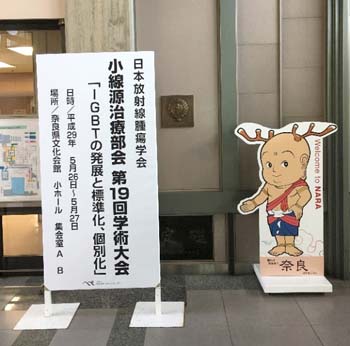2017.5.26 ~ 5.27:The 19th Annual meeting of Brachytherapy Group / JASTRO
The 19th Annual meeting of Brachytherapy Group / JASTRO has been held in Nara Prefectural Cultural Hall, Nara, Japan. Mr. Abe (M2) has attended it for oral presentation.
■Date: May 26-27 ,2017
■Venue: Nara Prefectural Cultural Hall, Nara, Japan
■Conference name:The 19th Annual meeting of Brachytherapy Group / JASTRO

Kota Abe(M2)
We are pleased to report that Mr. Abe(M2) gave an oral presentation at the 19th Annual Meeting of the Japanese Society of Radiation Oncology Small Radiation Source Therapy Section held at the Nara Prefectural Cultural Hall (Nara City, Nara Prefecture) on May 26-27, 2017.
In recent years, image-guided small-body radiotherapy (IGBT) has been developed and popularized, and treatment planning has begun to shift from two-dimensional to three-dimensional. However, the transition to 3D treatment planning is not yet complete, and there are still large differences between facilities, so standardization and dissemination of guidelines are major issues. Against this backdrop, the theme of this year’s conference was “Development, Standardization, and Individualization of IGBT.
On the second day of the conference, a symposium on “Uncertainty in Small Radiation Source Therapy” was held. The symposium featured presentations by prominent physicians and physicists on uncertainties specific to small source therapy, which was of great interest to me as well. I was reminded that uncertainty evaluation is important both in clinical practice and in research, because it means that one is able to look at one’s own process from a comprehensive perspective.
I presented my research on the calculation accuracy of heterogeneity-corrected model-based dose calculation algorithms, which have been implemented in small source treatment planning devices since the transition to 3D treatment planning began. Currently, the TG43 method, which assumes that the entire body is water, is the mainstream dose calculation method for small-source radiation therapy. However, the improved accuracy of dose calculation for small-source therapy using heterogeneity-corrected dose calculation may lead to more accurate dose summation using DIR. Since there are still few reports on inhomogeneity-corrected dose calculation in the Small Radiation Source Division, and even fewer cases where it is combined with DIR dose estimation, we will continue to study inhomogeneity dose calculation and dose estimation using DIR in our laboratory and hope to present our findings at various conferences in the future.
Finally, I would like to apply the knowledge I gained from this conference to my own research and clinical practice. I would like to take this opportunity to thank everyone who gave me this opportunity. Thank you very much.

Sento-kun greeted us.

Conferences

Sightseeing at Todaiji Temple between conferences
